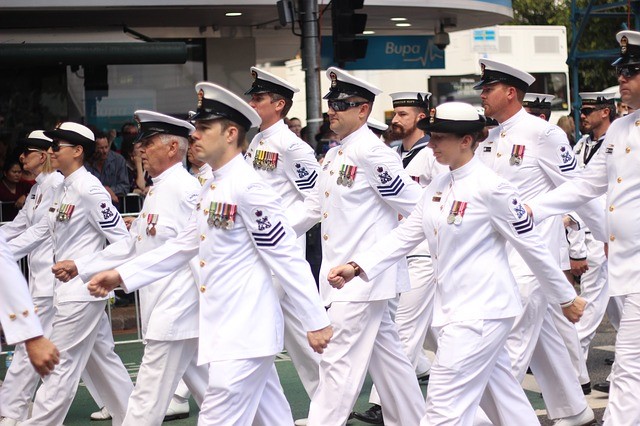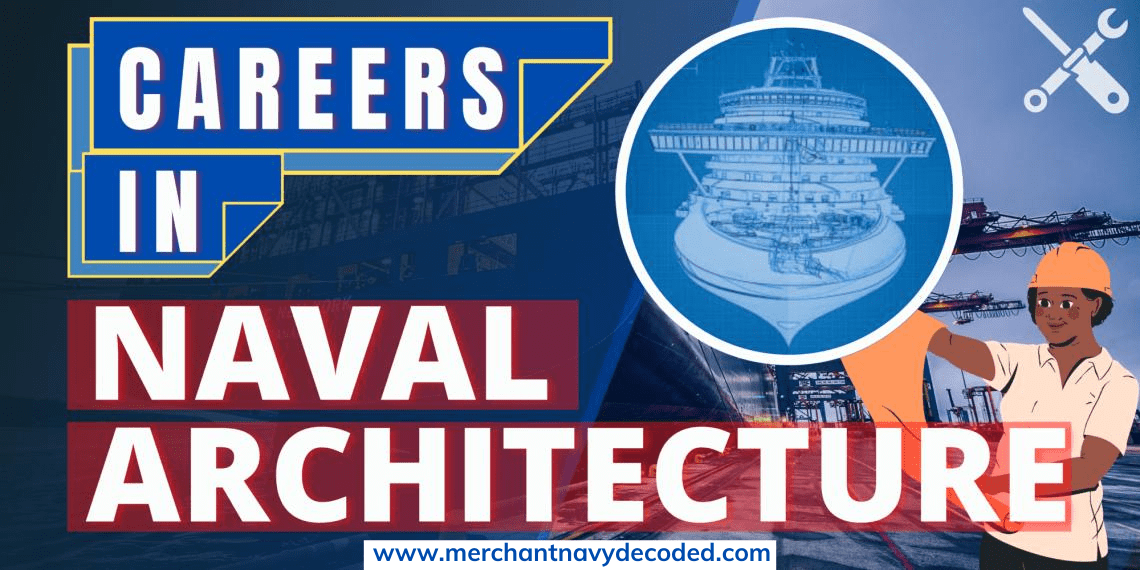Careers in Naval Architecture
Table of contents
- Who is a Naval Architect?
- Career Prospects in Naval Architecture
- Design
- Repair and Construction
- Sales and Marketing
- Consultancy
- Development and Research
- Instruction and Training
- Eligibility to Become a Naval Architect
- Skills Required for Naval Architecture
- Admission Procedure to Get Admitted into Naval Architecture
- Best Colleges for Naval Architecture in India
- Scope of B.Tech in Naval Architecture in India
- Jobs in Naval Architecture
Who is a Naval Architect?
A Naval Architect, in essence, is a civil and military professional engineer liable for the design, building, and maintenance of boats, ships, other marine vessels, and oversees a number of offshore constructions, such as, construction of:
- Merchant Ships – Oil / Gas Tankers, Cargo Ships, Cruise Liners, and so on.
- Warships like Frigates, Destroyers, Aircraft Carriers, Amphibious Ships, among others.
- Submarines and undersea vehicles.
- Offshore Drilling Platforms, Semi Submersibles, and FPSOs.
- Hovercraft, Multi-Hull Ships, Hydrofoil Craft, and other High-Speed Crafts.
- Workboats – Fishing Vessels, Tugs, Pilot Vessels, Rescue Craft, and other Recreational Craft.

A number of these vessels are rightfully considered to be some of the world’s largest, most intricate and valuable constructions. In their absence, the modern world, as we know of today, would probably never be able to transport and procure the raw materials and products in such a rapid, economic and secure fashion.
In the current scenario, modern engineering is by large, a collaborative effort involving professional engineers from several domains and specialties. The Naval Architect, for instance, is the one who connects everything together and is ultimately responsible for the project. Thus, the difficult leadership role necessitates managerial abilities and the capacity to reconcile the frequent contradictory needs of the many professional engineering disciplines involved in order to deliver a “fit for purpose” product.
Further, the Naval Architect also has a specific role in ensuring that a safe, cost-effective, and seaworthy design is generated, in addition to his or her important administrative position.

To complete all of these jobs, the Naval Architect must be well-versed in a variety of technical disciplines and be at the cutting edge of high-tech fields such as computer-aided design and calculation. He or she must be able to efficiently utilize the services of scientists, lawyers, accountants, and various types of business people.
A Naval Architect should possess an ingenious, inquisitive, and logical bent of mind, and be well – versed in both written and oral communication, so as to converse clearly with people both inside and outside the engineering profession, as well as a solid judgement and leadership abilities. His or her education and training are meant to help him or her develop these talents and earn recognized certifications and professional standing.
Career Prospects in Naval Architecture
Around the world, there are a number of settings that Naval Architects can easily breeze through. Although it’s difficult to categorize specific roles due to their diverse and inter – disciplinary work, here are a few broad fields where they could work:
- Construction and Repair
- Design
- Advisory
- Marketing and Sales
- Operations
- Regulation, Surveillance, and Oversight
- Research and Development
- Education and Training
Each listed field is unique, entails a different opportunity for initiative, implores the individual to bring about ingenuity in a wide range of technical and managerial positions, and offers enthralling instances of international travel. The workplace could be either a huge corporation, a small business, a consulting firm, or a government agency.
Naval Architects can either specialize in one subject or get wide knowledge in a number of others, with the discretion solely dependent on their qualifications and personal preferences. Later, they could be performing in senior executive roles, effectively utilizing their general management knowledge and experience, as well as their engineering and project management professional talents.
Typically, Professional Naval Architects are efficient enough at top managerial positions in government, industry, and commerce outside of the maritime sphere, thanks to the breadth of their education, training, and experience.
Design
Naval Architects are, by definition, incredibly creative individuals. They must necessarily be familiar with the many aspects of ship design, including function, appearance, and, most importantly, safety at sea. They must be team leaders, able to integrate the contributions of a large number of people into a balanced, logical and meaningful whole. In addition to the architectural components of ship form and layout, they must be able to employ complicated mathematical and physical models to guarantee that the design is technically satisfactory and follows the safety laws and standards established by Classification Societies and Government Agencies.

A ship, boat, or offshore structure must be stable, seaworthy, and strong enough in all weathers, as well as have appropriate hydrodynamic (and, in the case of sailing boats, aerodynamic) performance to provide economical propulsion and a safe and comfortable motion in all sea states. The design process necessitates the use of computer-based information and communication systems extensively.
Ship and boat builders, offshore constructors, design consultants, and the Ministry of Defence for the Royal Navy’s ships and submarines are all employers of Naval Architects involved in design work. Propulsion systems, auxiliary systems, subsea production systems, and control systems are all designed by teams of engineers, including Naval Architects, at major equipment manufacturers.
Repair and Construction
The ship and boat builder’s and offshore constructor’s job is to turn blueprints and detailed specifications into actual structures. A Naval Architect who specializes in building usually takes a managerial position, overseeing the yard as whole or specific areas such as design, production, or the intricate process of fitting out. Through the implementation of new procedures and methods, as well as increased training for the workforce, there is a constant effort to save money using existing techniques and equipment. The Naval Architect must also plan for the delivery of the products and components, as well as inspection and testing, along with manpower.

Construction and repair work have a lot in common. In this discipline, naval architects become professional managers who, like builders, must grasp current management and related skills. Emergency repair work usually requires innovation and on-the-spot improvisation, and in the offshore engineering field in particular, underwater technology is commonly used.
Large and small shipbuilders and repairers, as well as those involved in the maintenance and repair of navy ships and submarines, use Naval Architects in building and repair. Naval Architects make up a major percentage of senior technical managers and executives in the marine industry in the United Kingdom.
Sales and Marketing
Customers in the maritime industry rely on Naval Architects for professional guidance and technical support.
Many shipping corporations have technical departments where Naval Architects are in charge of the various stages of ship and equipment purchase as well as the resolution of difficulties impacting maritime operations’ economics.
Regulation, Surveying, and Overseeing Naval Architects employed by Classification Societies as Ship Surveyors are involved in evaluating the safety of ships and marine structures around the world using the Society’s Rules and those of intergovernmental organizations such as the International Maritime Organization.
Before construction, plans for ships that will be built and subsequently classed with the Society are scrutinized, and characteristics of design such as strength, stability, and lifesaving are authorized.
Ship Surveyors inspect the craftsmanship and materials used during construction to ensure that they are in line with the Rules and Regulations. Once the vessel or structure is in service, Ship Surveyors will continue to check it to ensure that any major problems discovered during operation are repaired and that the structure remains safe and seaworthy. Naval Architects are employed by government departments and are primarily responsible for the development of safety rules as well as the safety surveying of ships and equipment.
Naval Architects are employed by ship operators and the Ministry of Defence to oversee the building and repair of their warships.
Consultancy
As consultants, Naval Architects offer engineering solutions, technical and commercial advice, support, and project management for concept design studies, new vessel constructions, refits, and conversions. The Naval Architect enjoys the variety of work since it presents a fulfilling challenge.
Development and Research
Maritime research in the United Kingdom has a global reputation, and Naval Architects, many of whom hold post-graduate degrees, are engaged in research in institutions and industry across the country. Classification Societies also invest in research and development, employing Naval Architects in this capacity.
Instruction and Training
Often, engineering careers demand a solid educational foundation. As such, quality Naval Architects with sound knowledge are more than often needed to work as professors or lecturers at reputed universities or colleges.
Eligibility to Become a Naval Architect
In order to get admitted in Naval Architecture Courses, a prospective student must meet certain pre – requisites. Although, each college may have its own set of Minimum Requirements, a few universal eligibility criteria are listed below:
For Undergraduate Courses:
- Candidates must have taken and passed the 10+2 Standard Examination (or an equivalent Examination) from a recognized Board.
- They must have studied the subjects: Physics, Chemistry, and Mathematics necessarily in the 10+2th grade.
- They must have acquired a minimum of 50 % of overall grade point average.
For Postgraduate Courses:
- Candidates must possess a Bachelor’s Degree in Naval Architecture.
- Candidates must have completed graduation from a reputable institute.
- Candidates seeking admission in Diploma Courses must have passed the 10th Standard Examination.
- They must have acquired the required minimum marks in the subjects of Physics, Chemistry, and Mathematics.

Skills Required for Naval Architecture
Although each individual brings something novel and ingenious to his work sphere, there are certain skills that a prospective individual must aim to develop or seek to flourish in the industry. These skills do give an edge over the ones who lack them, and can certainly help one succeed. Listed below, they are:
- Proficiency in written and verbal communication.
- Inter – personal and leadership ability
- Analytical skills and Mathematics
- Keen Observation
- Creativity
- Technical Ability
- Problem-solving and Critical Thinking
- Ability to work in a Team.
Admission Procedure to Get Admitted into Naval Architecture
Most of the institutions that offer Degrees in Naval Architecture generally intake students based on their performance in the Entrance Examinations. Often, following the entrance exam, the qualified candidates are called in to participate in the required counseling process or personal interview, successful completion of which leads to an admission in the institute. However, depending on the degree sought, a few colleges also provide admission based on the 10+2, Bachelor’s or 10th Standard Marks.
A few of the Entrance Examinations that candidates seeking admission into Naval Architecture must look into are listed below.
IMU – CET
Administrated by the Indian Maritime University (IMU), good performance in the exam leads to admission into Courses in the reputed institute IMU. The results are also utilized by several participating institutions that offer admissions based on its score.
JEE Mains
The famed exam JEE Mains comes under the charge of the National Testing Agency (NTA), which conducts it to offer admissions into the several IIITs, NITs, and GFTIs.
GATE
GATE Score is utilized by several institutions to take admissions into MTech Courses. It is jointly conducted by the prestigious IISc Bangalore and the seven IITs, annually.
Best Colleges for Naval Architecture in India
- IIT Kharagpur – Indian Institute of Technology (IITKGP)
- IMU – IMU Vizag Indian Maritime University
- School of Ocean Engineering, VELS Institute of Science, Technology and Advanced Studies
- IIT Madras – Indian Institute of Technology Chennai (IITM)
Scope of B.Tech in Naval Architecture in India
Many opportunities exist for Naval Architects in the private, educational, corporate, and governmental sectors. One could easily venture out in the following areas:
- Offshore Oil Recovery
- Marine metals and corrosion
- Environmental Protection
- Global Climate Monitoring
- Renewable Energy
- Underwater Vehicles
- Remote Sensing
- Marine Transportation
- Naval Architecture and Defence
a. In Indian Navy
Further, exciting prospects exist for Graduates in Naval Architecture in the prestigious Indian Navy. Naval Architects employed here particularly specialize in submarine and warship construction. They are responsible for design, quality control, repair and construction of Indian Naval vessels.
Being an Officer in the Naval Architecture Cadre, one performs a wide spectrum of tasks including design of warships and submarines, overseeing of construction at various shipyards, platform trials at sea, appointment onboard warships as well as refit and operational support for ships and submarines, including dry docking. Further, one can always keep abreast of latest advancements in ship-building technology. Such a vibrant and dynamic life is certainly something that only a very few can dream of, for in no other career, an Architecture Officer gets exposure to such wide developments.
b. In Corporate Sector
Some Popular Corporations that hire Naval Architects based in India are listed below:
Public Sector Shipyards
- Mazagon Dock Shipbuilders Limited
- Garden Reach Shipbuilders Engineers Ltd.
- Cochin Shipyard Limited
- Goa Shipyard Limited
- Hindustan Shipyard Limited
Private Sector Shipyards
- Larsen and Toubro Shipbuilding
- Reliance Defence Industries Limited
- Tebma Shipyard Limited
Classification Societies
- Indian Register of Shipping
- Lloyds Register
- Marine Design Consultancies and Firms
- Vedam Design
- Aries Marine Consultants
- Marintek
- Conceptia
- Buoyancy Consultants
- Bharti Shipyard Ltd
- Larsen and Turbo Ltd
- Cyber marine Knowledge Systems Pvt Ltd
- Shipping Corporation of India Ltd
- ABG Shipyard Ltd
Jobs in Naval Architecture

Both commercial and public sectors offer lucrative prospects which an individual could pursue after completing his / her Naval Architecture degree. One could either go for further studies or seek professional options (i.e., Jobs). Students can namely pursue the following job profiles, once their education is complete:
Naval Architect Coastal Engineer
Primarily responsible for the design and construction of artificial ports. They work for the safety of the ambient port and to improve connectivity to coastal areas.
Naval Architect Marine Engineer
The principal duty of a Marine Engineer is to design, build, test, and repair ships, boats, underwater crafts, offshore platforms, and drilling equipment.
Port Manager
Such individuals are responsible for planning, administering, and reviewing port terminal operations.
Ship Operator
A ship operator is in charge of handling the vessel’s bunkers, crew members, appointments, and other details.
Oceanographers
Are crucial for investigating the motion and circulation of ocean waters as well as its impact on weather, climate, coastal areas, and other factors.
A Marine Surveyor
Are chiefly designated to inspect, survey, or examine marine boats in order to assess, monitor, and report on their condition and the products on board. They also offer specialized advice to the shipping business.
Disclaimer :- The opinions expressed in this article belong solely to the author and may not necessarily reflect those of Merchant Navy Decoded. We cannot guarantee the accuracy of the information provided and disclaim any responsibility for it. Data and visuals used are sourced from publicly available information and may not be authenticated by any regulatory body. Reviews and comments appearing on our blogs represent the opinions of individuals and do not necessarily reflect the views of Merchant Navy Decoded. We are not responsible for any loss or damage resulting from reliance on these reviews or comments.
Reproduction, copying, sharing, or use of the article or images in any form is strictly prohibited without prior permission from both the author and Merchant Navy Decoded.




Can a person with Bachelor in Architecture or Master in architecture join naval architecture course.
The best way to know would be to call the respective colleges or mail them to know the proper details.
Currently there is an acute employment issues&those employed are paid pittance fir their work in india
Thank you for this amazing blog. You explained everything very well about naval architecture in<a href= “http://gracenavigation.com/” title=”Merchant Navy”>Merchant Navy</a.
thankyou jyoti
Why Naval architecture course offered by Cochin university not mentioned